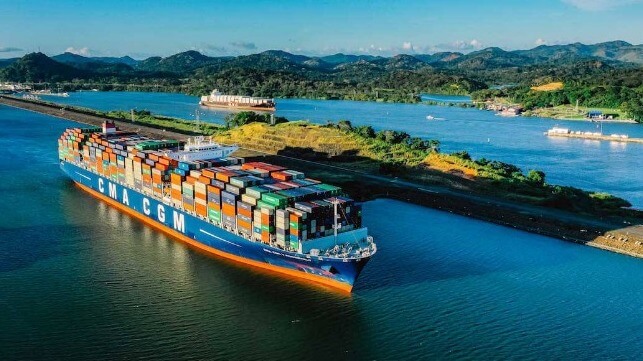Panama Canal Further Restricts Drafts Due to Falling Water Levels

In an advisory to shipping the Panama Canal Authority (ACP) announced further restrictions for the maximum authorized draft in locks as it is confronted by the worst drought in a century. The authority also mapped out a series of additional steps that could see the maximum draft reduced by nearly a quarter in the Neopanamax locks during the first half of 2023 as forecasters warn the situation could worsen with the arrival of the weather phenomenon known as El Niño.
The Canal Authority mapped out the next steps for the restrictions starting yesterday for the Neopanamax locks. Having been at a peak level of 50-foot drafts until the spring of this year, the ACP reported the maximum authorized draft would be moved to 44 feet down a further half a foot. Next week they plan to further step it down to 43.5 feet followed by a further half a foot to 43 feet as of July 19. Similarly, the original Panamax locks, which are used by the majority of the ships transiting the canal, will see their maximum draft moved to 39 feet as of July 9 and 10 days later lowered another half a foot to 38.5 feet.
“This is an issue that the Panama Canal has been warning and preparing for, however, we could not have predicted exactly when the water shortage would occur to the degree that we are experiencing now,” said Canal Administrator Ricaurte Vásquez Morales. The ACP calculates that rainfall during the first five months of 2023 is down 47 percent versus historic norms.
Historically the ACP reports it experienced droughts every five years but as the climate crisis has accelerated globally, they are now coming more frequently at three-year intervals. They note that the last period of intense drought in the canal took place in 2019-2020.
They are reporting that only a limited number of ships, mostly the giant containerships, have had to lower their draft levels so far to comply with the limits. LNG carriers, which make up another large part of the canal’s traffic, typically report drafts of up to 37 feet according to ACP meaning that they have been able to continue their transits.
According to a report in The Wall Street Journal, containerships have taken to offloading boxes on the Pacific side of the canal and using the Panama Canal Railway to move containers across to the Atlantic terminal where they can be reloaded. The newspaper reports volumes were up 20 percent on the rail line in recent weeks.
Morales told The Wall Street Journal, “The rainfall volume has been consistently falling over the past 20 years. We are dealing with a climate crisis when we are at peak capacity, and we have to find new sources of water to store in our lakes.”

that matters most
Get the latest maritime news delivered to your inbox daily.
The Panama Canal Authority reports it has taken steps to prepare for the current drought conditions and to conserve water usage when possible. The primary near-term action they can take is to further restrict the draft levels, although they have said they would also consider restricting the number of daily transits if the problem worsens. The ACP in its advisory dated June 13 said it will “continue to monitor the level of Gatun Lake and announce further draft adjustments in a timely manner.”
The long-term water plan had called for tapping additional rivers expanding on the Chagres River, the largest river in the Panama Canal's watershed. The original canal builders dammed the Chagres in two places to create Gatun Lake and the water used for the locks. The ACP is now seeking to accelerate its plan to divert four additional rivers into the watershed over the next 10 years. The plan had called for the work to take place over 25 years and cost over $2 billion.
